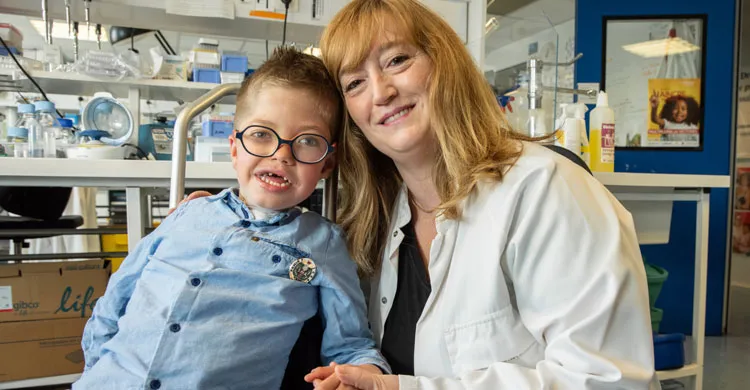Myotubular muscular dystrophy: trial results show efficacy on respiratory and motor function, but challenges remain

A gene therapy developed at Genethon by Ana Buj Bello's team is proving effective in a rare and very severe muscle disease: myotubular myopathy. Review of the results published online in The Lancet Neurology on November 15.
The Lancet Neurology has just published the clinical results of the gene therapy trial for myotubular myopathy, conducted by Astellas Gene Therapies in 6 investigating centers worldwide, using a drug candidate developed at Genethon.
24 children under the age of 6 suffering from myotubular myopathy and on respiratory assistance for at least 22 hours a day were treated in two cohorts: 7 of them with a first dose, 17 others with a second, higher dose. One young patient was treated in France, at the I-Motion paediatric clinical trials center at the Institut de Myologie in Paris, by Dr Andreea Seferian, neuropaediatrician and trial investigator.
Five years after the trial began, the results show that:
- 16 children were able to do without respiratory assistance, previously essential 22 hours a day, between 14 and 97 weeks after treatment.
- 20 children could sit up for at least 30 seconds. Of these, 12 can stand up on their own and 8 can walk without support, whereas no child could do so before the treatment with the drug developed at Genethon.
- 4 children showing a priori signs of pre-existing hepatobiliary pathology died. The trial has been suspended while the cause of these complications is investigated.
"I have devoted my entire career to working on myotubular myopathy. It took years of research to imagine, design and demonstrate the efficacy of the drug vector for this very severe and complex disease. Even if we absolutely have to understand the reasons for the side effects observed in this clinical trial, it is exceptional to see children who thought to be doomed make incredible progress thanks to this drug candidate," emphasizes Ana Buj-Bello, a researcher at Genethon, director of research at Inserm and co-author of the preclinical work that led to this clinical trial.
"These clinical results show both how spectacularly effective gene therapy can be and the challenges that remain, particularly in terms of side-effects in certain contexts. While our teams are already committed to understanding and anticipating these issues, the knowledge gained from this clinical trial, which highlights certain limitations and specific hepatic susceptibilities, is rich in lessons for the entire scientific community. I would like to pay tribute to the excellence of Ana Buj-Bello's work, which has led to major therapeutic effects in the majority of children treated, and which represents the first potential treatment for this rare and fatal disease," adds Frédéric Revah, Chief Executive Officer of Genethon.
The results of this clinical trial demonstrate major therapeutic effects, enabling children who were previously hypotonic, tracheostomised and gastrotomised to breathe on their own, stand up and even walk. Gene therapies therefore represents the first potential treatment for this rare and fatal disease.
Jules benefited from this gene therapy treatment as part of this clinical trial and was treated at I-motion. Today, he who was a "prisoner of his body", unable to move or breathe on his own, is making progress every day: he no longer needs respiratory assistance, walks, runs and cycles... Read his story.
What is myotubular myopathy?
Myotubular myopathy is a rare genetic disease that affects one boy in 50,000 and is characterized by extreme muscle weakness and severe respiratory failure. 50% of children with the disease die before the age of 18 months, and 75% before the age of 10.
Also read: Advances in congenital myopathies
